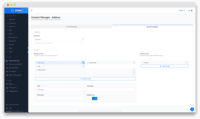Overview
What is Strapi?
Strapi is an open-source software platform that helps developers to easily build, deploy, and manage APIs.
Recent Reviews
Pricing
Entry-level set up fee?
- No setup fee
Offerings
- Free Trial
- Free/Freemium Version
- Premium Consulting/Integration Services
Would you like us to let the vendor know that you want pricing?
3 people also want pricing
Alternatives Pricing
Product Demos
Get started with Strapi v4 in 3 minutes
YouTube
03. -Strapi en Español- ¿Por que usar Strapi?
YouTube
Image Formats Plugin for Strapi Demo 1
YouTube
Admin roles overview
YouTube
Strapi Import Plugin Demo 2
YouTube
Create a comment system for articles
YouTube
Product Details
- About
- Competitors
- Tech Details
What is Strapi?
Strapi enables content-rich experiences to be created, managed and exposed to any digital product, channel or device. The vendor provides that it is self-hosted, 100% Javascript, headless, and state that they're committed to keeping it community first and open-source.
Strapi is vendor-agnostic, it is designed to work with all the JAMstack sites, static site generators such as React, Next.js, Nuxt.js, Vue.js, Gatsby or Angular, supports both SQL and NoSQL databases and can be hosted anywhere you want: AWS, Netlify, Heroku, a VPS, or a dedicated server.
Strapi is an open-source project. The core project, as well as the documentation and any related tool can be found in the Strapi (opens new window)GitHub organization.The following GitHub repositories are open-source and contributions-friendly:
1. strapi/strapi (opens new window): main repository of Strapi, which contains the core of the project. You can find the admin panel, core plugins, plugin providers, and the whole code that runs your Strapi application. Please read the CONTRIBUTING.md (opens new window)file to have more information about contributions to the main repository.
2. strapi/documentation (opens new window): contains the whole documentation of Strapi. Please read the contribution guide (opens new window)to have more information about contributions to the Strapi documentation.
3. strapi/design-system (opens new window): is the design system that is used in the admin panel. It brings consistency between the different admin plugins.
4. strapi/strapi-docker (opens new window): contains the code used to generate the official Docker images for Strapi (available through our Docker Hub (opens new window)).
5. strapi/awesome-strapi (opens new window): contains everything the community built and all managed plugins. It is used as a central place to find and submit new packages such as plugins, middlewares, hooks, and general enhancements to the core of Strapi.
Strapi Features
Web Content Creation Features
- Supported: WYSIWYG editor
- Supported: Admin section
- Supported: Page templates
- Supported: Mobile optimization / responsive design
Web Content Management Features
- Supported: SEO support
- Supported: Availability / breadth of extensions
- Supported: Community / comment management
Platform & Infrastructure Features
- Supported: API
Security Features
- Supported: Role-based user permissions
Strapi Screenshots
Strapi Competitors
Strapi Technical Details
| Deployment Types | On-premise |
|---|---|
| Operating Systems | Windows, Linux, Mac |
| Mobile Application | No |





